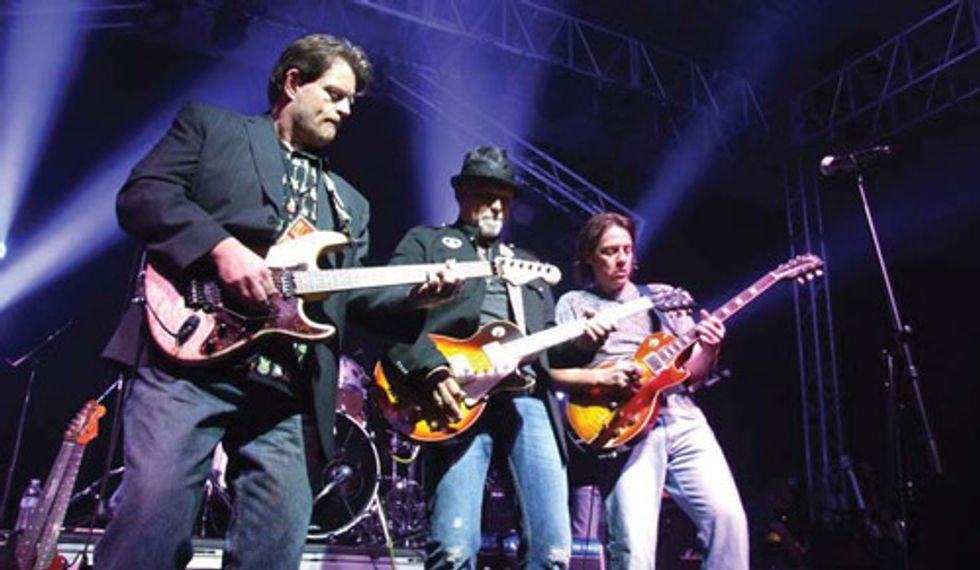When I was a kid growing
up in Maryland, I loved
going to concerts and seeing the
big walls of amps onstage. You’d
always see a towering stack of amps
behind bands like Van Halen, Y&T,
or Ted Nugent. Because I wanted
to emulate those guys, of course I
was motivated to buy the biggest,
loudest amps I could find. In the
late ’70s, I saw a magazine ad with
Eric Clapton playing through three
huge Music Man HD-130 amps.
They stood taller than him, and a
curly cord dangled seductively from
the input of one of the heads. I had
to have one. In the ad, his Gibson
Firebird also gripped a cigarette
between the strings and the headstock,
and this looked every bit as
cool as the guitar itself. (Fortunately,
it didn’t encourage me to take up
smoking.) While I was still in high
school, I saved up my gig money
to purchase a Music Man HD-130.
The head sported EL34 tubes and it
was my first really professional guitar
rig. To mimic the Clapton ad, I
bought two of the 4x12 cabinets and
stacked the head on top. It was all
about the look.

(Left to right) Roger Eaton, Derek St. Holmes, and Rich Eckhardt jam at the ReTune Nashville
Charity Concert, October 23, 2010. Photo by Dave Dudek
The 130-watt RMS rating was way more amp than I ever needed. In hindsight, I would have been better off with Music Man’s Series 65 head—the 65-watt version of the 130. But I was convinced louder was better, and if Clapton was using the 130, it was the amp I had to have. I’m convinced if someone had made a 500-watt amp, I would have bought it and wondered if a 600- watt amp wouldn’t sound better.
I’ve since learned you can do a lot more with smaller amps. Their power tubes overload more easily, and that breakup gives you a much fatter tone at the right level. Even though big amps look cooler than a monkey on a dirt bike, you rarely need enough volume to single-handedly fill an arena. On those gigs, your amp will be mic’d and run through the PA anyway.
A few weeks ago, while performing on a Nashville benefit show, I had the pleasure of sharing the stage with my longtime buddy and fellow axe man, Roger Eaton. Roger has played with some of the biggest names in country music, including Barbara Mandrell, Joe Diffie, and Tanya Tucker. He showed up on the gig with an impressively compact rig consisting of an Ugly Amps 18-watt head and cabinet. The tiny, 2-channel Ugly had two EL84 power tubes and two 12AX7 preamp tubes, and it just plain smoked on the clean country stuff. Additionally, he brought a beefed-up Fender Princeton-style combo made by Rick Hayes at Vintage Sound Amps. It kicked out about 15 watts with a 12" Warehouse Guitar speaker.
Roger ran everything through an imposing pedalboard that allowed him to cover a variety of straight-ahead tones, as well as a few specialized sounds. He also brought an assortment of Clayton and KSM guitars—one of which was a custom-made instrument he’d just picked up on the way to rehearsal.
By contrast, I played a Les Paul Standard and filled the left side of the stage with a 100-watt Marshall JCM900 and a 4x12 cabinet. My Marshall’s previous owner was more of a collector than a player, and he’d only turned it on four or five times in 17 years. It’s one of the early 900-series amps that still has the warmth of the classic vintage Marshalls. I’ve only had this amp for a short time, and I’m still learning all that it can do. A rare find, it’s one of the best-sounding Marshalls I’ve ever played through.
But two guitarists can get onstage with substantially different setups and sonically complement each other, rather than battle each other for space and volume. Approaching the guitar parts with two completely different rigs, Roger and I knew it didn’t have to be the fight of the week: In this corner, weighing in at 122 pounds, 6 ounces, is the World Champion Marshall half-stack! And in this corner, at a scrappy 40 pounds, 1 ounce, is the legendary Fender Princeton. Ding, ding, ding—come out fighting and keep it clean, boys!
Roger and I took two different approaches to the same gig, and that gave the show so much more character and diversity than if we’d both played through the same make and size of amps and used similar guitars. The Eagles have a rule of thumb: If one guitarist is playing a Strat, the other should be on a Les Paul. By following this principle, Roger and I brought a lot of depth to the band’s sound. The show featured a wide variety of artists, and we covered everything from old Patsy Cline to Ted Nugent—and we made it work.
Next time you find yourself in a similar situation, consider this mix-and-match approach. It’s a great way to make your music sound as good as it can.
Rich Eckhardt is a Nashville guitarist who has performed with singers ranging from Steven Tyler to Shania Twain. He currently plays lead guitar for Toby Keith, and also works as a spokesperson for the Soles4Souls charity (soles4souls.org). His new album, Cottage City Firehouse, is available at richeckhardt.com and CDBaby.com.






![Rig Rundown: Russian Circles’ Mike Sullivan [2025]](https://www.premierguitar.com/media-library/youtube.jpg?id=62303631&width=1245&height=700&quality=70&coordinates=0%2C0%2C0%2C0)


























